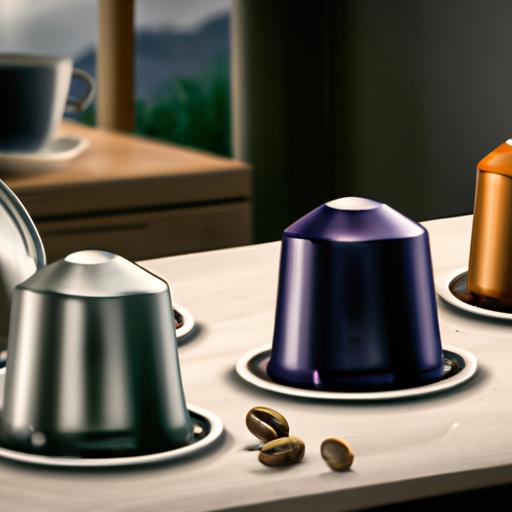Coffee is a staple of the daily routine for millions of people around the world.
We rely on it to get us through the day and make us feel alert, energized, and ready to tackle whatever tasks lie ahead.
But with the rise of single-serve coffee pods, just how many of these tiny cups of convenience are used each day? The answer may surprise you.
In this article, we’ll explore the rise of coffee pods, the benefits they offer, and the impact they have on the environment.
We’ll also look at the latest findings from a National Coffee Association survey to estimate the number of coffee pods used each day and compare those results to additional estimates.
So grab a cup of joe and let’s dive into the world of coffee pods.
Table of Contents
Short Answer
The exact number of coffee pods used each day is difficult to determine, as it depends on the size and location of businesses and households that use them.
However, it is estimated that around 25 million coffee pods are used each day in the United States alone.
This number is expected to grow in the coming years, as coffee pods become more popular and more widely available.
The Rise of Coffee Pods
Coffee pods have taken the world by storm in recent years, offering convenience and a wide variety of flavors that appeal to coffee drinkers of all ages.
The rise of coffee pods is attributed to the development of single-serve coffee machines, which allow users to brew a single cup of coffee in a matter of seconds.
This has made coffee pods an attractive option for households and businesses alike, as it eliminates the need for a larger coffee maker and allows users to enjoy their favorite coffee flavors in no time.
Coffee pods come in a variety of flavors, from classic espresso to creamy cappuccino and decadent mochas.
They are also available in a range of sizes, from single-serve pods to larger pods that are designed to brew multiple cups of coffee.
This makes them incredibly versatile and allows users to tailor their coffee experience to their own preferences.
In addition to the convenience and variety of flavors, coffee pods are also becoming increasingly popular due to their environmental friendliness.
Unlike traditional coffee makers, which require disposable filters and paper cups, coffee pods can be recycled and reused with the help of special recycling centers.
This makes them a more sustainable option for those looking to reduce their environmental impact.
The increasing popularity of coffee pods has led to a surge in sales, with the global coffee pod market estimated to reach $29.9 billion by 2025.
This suggests that a large number of coffee pods are being used every day, though the exact number is difficult to pinpoint.
The Benefits of Coffee Pods

Coffee pods have become increasingly popular in recent years due to their convenience and wide variety of flavors.
They provide an easy way to make a single cup of coffee, without having to measure out exact amounts of coffee grounds or wait for a pot to brew.
Plus, they come in a variety of flavors, from classic coffees to seasonal favorites like pumpkin spice.
This means that coffee drinkers can enjoy the same great taste in a convenient, single-serve format.
In addition to convenience, coffee pods also offer environmental benefits.
Since each pod contains just enough coffee for one cup, theres no waste from over-brewing or stale coffee grounds.
Plus, the pods themselves are recyclable, making them a more sustainable choice than traditional coffee makers.
Finally, coffee pods are often more cost-effective than regular coffee makers.
Since one pod contains enough coffee for a single cup, you dont have to buy a whole bag of coffee grounds in order to make multiple cups.
This makes them a great choice for people who dont drink coffee regularly, or for households that have multiple coffee drinkers with different preferences.
Estimating the Number of Coffee Pods Used Each Day
Estimating the exact number of coffee pods used each day is a difficult task, as there is no comprehensive data tracking the sales and usage of coffee pods.
However, by looking at various surveys and estimates, we can get an idea of how many coffee pods are being used each day.
The National Coffee Association’s 2018 survey revealed that 12% of American adults consume single-serve coffee pods.
This figure has likely increased since then, as the popularity of coffee pods have grown over the past few years.
Additionally, other estimates put the total number of American coffee pod drinkers as high as 20%.
This suggests that a significant number of coffee pods are being used each day.
However, it is difficult to accurately estimate the exact number.
One way to get a more accurate estimate is to look at sales data from coffee pod manufacturers.
This data would provide an accurate picture of the number of coffee pods being sold and consumed each day.
Another way to estimate the number of coffee pods being used each day is to look at the number of coffee pods being recycled.
Coffee pods are generally made of plastic or aluminum, and these materials can be recycled.
By looking at the number of coffee pods being recycled, we can get an idea of how many coffee pods are being used each day.
In conclusion, it is difficult to estimate the exact number of coffee pods being used each day due to the lack of comprehensive data.
However, by looking at surveys and sales data, we can get an idea of how many coffee pods are being used.
Additionally, looking at the number of coffee pods being recycled can provide us with an estimate of the number of coffee pods being used each day.
Results of the National Coffee Association Survey

The National Coffee Association’s survey revealed that 12% of American adults consume single-serve coffee pods, a figure which is much higher than previously thought.
The survey also found that the majority of these coffee pod drinkers are younger adults, with millennials making up the largest group at 42%.
Interestingly, the survey showed that despite the higher prevalence of single-serve coffee pods among younger adults, older adults are still consuming them at a significant rate.
The survey revealed that 32% of Gen Xers and 12% of Baby Boomers also drink single-serve coffee pods.
Additionally, the survey found that the convenience of single-serve coffee pods is a major factor in its popularity, with 52% of respondents citing convenience as the primary reason for their use.
This is followed by the flavor variety offered by coffee pods, with 40% of respondents citing this as a factor.
With the wide variety of flavors available, it’s no surprise that coffee pods are increasingly popular.
The survey also found that the majority of coffee pod drinkers prefer to brew their coffee using a single-serve machine, with 56% of respondents saying that this is their preferred method.
This suggests that more people are opting for the convenience of single-serve machines, as opposed to traditional methods like French press or pour-over coffee.
This could explain why the popularity of coffee pods is on the rise.
Overall, the survey revealed that single-serve coffee pods are becoming increasingly popular among all age groups, with convenience and flavor variety being the two main factors in their appeal.
With the wide variety of flavors available, it’s no surprise that coffee pods are becoming a popular choice for coffee drinkers.
Additional Estimates of Coffee Pod Use
In addition to the survey conducted by the National Coffee Association, other estimates of coffee pod use can be found in research studies and reports.
For instance, a report published by the Specialty Coffee Association of America (SCAA) in 2018 estimated that the total number of coffee pods consumed in the United States each day is approximately 3.1 billion.
This figure is based on the number of pods sold in 2017, and it suggests that daily consumption is increasing at a rapid rate.
Furthermore, the same report estimated that the total amount of coffee consumed in the United States each day is the equivalent of 28 million cups.
This suggests that Americans are drinking more coffee than ever before, and that coffee pods are becoming an increasingly popular way to get their daily caffeine fix.
Finally, a study conducted by the International Coffee Organization (ICO) in 2019 found that the global market for coffee pods is expected to reach $29.8 billion by 2024.
This figure is based on the estimated number of coffee pods consumed in 2018, and it suggests that coffee pod use is becoming increasingly popular worldwide.
Overall, while the exact number of coffee pods used each day is difficult to pinpoint, estimates suggest that the figure is likely very high.
With coffee pods becoming increasingly popular due to their convenience and wide variety of flavors, it is likely that the number of coffee pods consumed each day will continue to rise.
The Impact of Single-Serve Coffee Pods on the Environment

The rise of single-serve coffee pods has had a significant impact on the environment.
The convenience of these single-serve coffee pods means that they are being used more frequently, but the amount of packaging and waste associated with them is difficult to ignore.
A single cup of coffee from a coffee pod can produce up to seven times more waste than a cup of coffee brewed from traditional grounds.
This waste often ends up in landfills or oceans, where it can take hundreds of years to break down and cause significant environmental damage.
In addition, the production of single-serve coffee pods requires more energy and resources than regular coffee grounds.
From the production of the plastic pods to the packaging and shipping, the entire process is energy-intensive and contributes to greenhouse gas emissions.
As the popularity of single-serve coffee pods continues to rise, so too does the environmental impact.
The good news is that there are ways to reduce the environmental impact of single-serve coffee pods.
Many companies are offering recyclable and/or compostable pods, which are much more eco-friendly than traditional options.
Reusing pods is also an option, as many brands now offer refillable, reusable coffee pods.
By making the switch to a more environmentally friendly option, consumers can help reduce the amount of waste and energy associated with single-serve coffee pods.
Alternatives to Coffee Pods
While coffee pods may be the most convenient and widely available option for a quick cup of coffee, there are other alternatives that can be just as tasty.
For those looking to reduce their environmental footprint, reusable pods are a great option.
Reusable pods are made of durable materials like stainless steel, and can be filled with your favorite coffee grounds for an easy, eco-friendly cup of joe.
Another great alternative to coffee pods are filter bags.
Filter bags are typically made of paper and filled with coffee grounds, and can be used in place of a coffee pod in most single-serve coffee makers.
Finally, for those looking for a more traditional cup of coffee, a French press is an excellent choice.
A French press is a simple glass and metal device that is used to steep coffee grounds in hot water, resulting in a strong and flavorful cup of coffee.
Final Thoughts
It’s clear that the use of coffee pods has grown significantly in recent years, with estimates of 12-20% of American adults using them every day.
This suggests that a large number of coffee pods are used each day, though the exact number is difficult to pinpoint.
With the environmental impact of single-serve coffee pods in mind, it’s important to consider more sustainable alternatives such as reusable coffee pods, which can help reduce waste and conserve resources.
Ultimately, it’s up to the consumer to make the decision that’s best for themselves and the environment.

